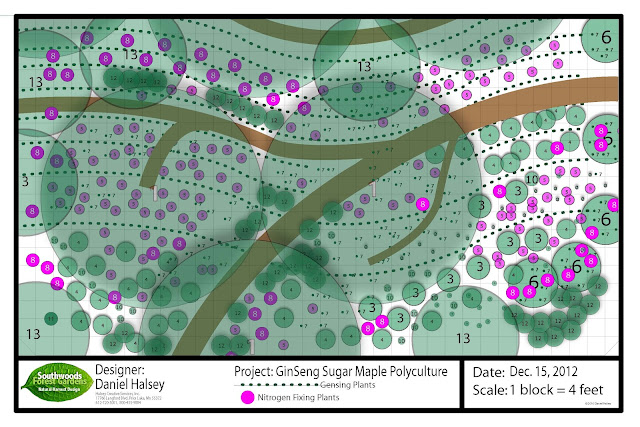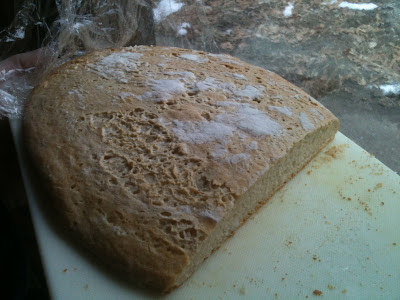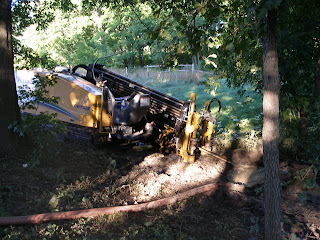Growing Medicinal Herbs in a Woodland Polyculture
Growing
Medicinal Herbs in a Woodland Polyculture
Abstract:
When individuals first learn about a new plant, many of them immediately
are excited to have the plant in their landscape and look for a source of seeds
and/or transplants to do so. What’s missing in many of these limitations is the
fact that all plants grow in ecology of companion plants. The niche in which a
species grows is filled with other plants that support it and the soil ecology.
Taking a plant out of its natural environment and isolating it in pots or
planting beds removes it from the supporting mechanisms that facilitate its
growth. This is followed by reduced yields, disease, and reduction of the
phytonutrients it might supply to its consumer. Cultivating these plants within
a supporting ecology where all ecological functions are present and filled by
plants with those functional roles may seem to reduce the yield, except for the
fact that yields in aggregate of all the associated plants far exceeds that of
the one.
Building a forest polyculture of any kind requires a considerable amount of planning and many sources
of material to research the niche and species available to deliver human uses
and ecological services. Keeping the final plant list to a minimum for the
initial placement of the ecologically functioning species will help build a
functional structure. After the initial 9 to 12 species are in place, including
the over story, a number of shrubs, companion perennials, and a groundcover
species, other plant species can be added.
Combining Chinese medicinal
herbs into an existing ecological system of natural plant Associates increases
the diversity of plant species, but also the disturbance regime frequency. If
human harvesting is increased in the forest poly culture, ecologically
supportive plants should also be increased. Nitrogen fixers, dynamic
accumulators, and nurse plants will mitigate the removal of nutrients. It
should be suggested that small patches of plants be implemented and studied
prior to any large change in a forest ecosystem, that being said, the forest
plants should be augmented with increased diversity, but still had a much
smaller proportion than what already exists.
Thanks to the Natural Capital Plant Database, PFAF, USDA, and Changbin Chen, University of Minnesota
Full Text
Woodland Medicinal Polycultures
The goal of this project is to augment agricultural forest woodland with ecologically functional plants and highly diverse sources of harvestable crops. The harvestable products from this forest garden will include food and medicinal crops[i] as well as increased ecological services and natural capital (E. Burkhart, 2007). A poly-culture design of associated species in a common niche will be based on high diversity and mutualistic mechanisms of facilitation. Plants will be placed in their proper niche relative to the partitions layers of the forest garden to be explained below. Not all the plants are perennials and some may need to be planted annually if not self-seeding.
The
major resources are partitioned spatially and temporally to allow for extended
growing periods and harvest. The major canopy plants will be dominated by
existing trees in the growing space. The existing ecology is the design driver
for selection of ecological analogues from available medicinal herbs. Using the
available ecological functions and services within the plant patch, ecological
requirements will be defined and used to select appropriate plants. Each plant
selected will have one or more functional roles to contribute to the
poly-culture. Priority will be given to plants that contribute to ecological
function and have a medicinal use or harvest. Special consideration will be
given to deciduous shrubs and perennials while low growing and ground cover
plants may have limited human uses and be selected for soil health and
production of organic material.
A
literature review will be made of available research papers from the Agricola
Database and other sources. Sources online from Cornell University and Ohio
State[ii]
have shown the incorporation of ginseng and ginger to existing hardwood
forests. The motivation for this institutional research has been expansion of
revenue-generating acreage in farming. It focuses on developing secondary and
low maintenance crops within an existing ecology requiring little input or
maintenance.
The
structure, placement, density, and plant type(s) will be developed prior to
species selection. This ensures that the functional roles required for
successful poly culture will be defined and appropriate species will be found
to fill those roles. Special attention will be made to effectively partition
the resources of each niche and fill all layers of the forest structure.
The
1st layer is the tall tree canopy,
the over story, the highest and tallest sun loving plants that begin to create
shade. The canopy trees are the long term over story and for this project have
been well established for many years in a healthy woodland. Care must be taken
to not disturb the ecological services previously existing in the planting area
or to cause stress to the trees involved. Long-term over story trees may
consist of nut producing deciduous trees and or conifers such as Korean Nut
Pine. In this case the major over story is Sugar Maple[v]
which provides excellent ecological services for the production of Ginseng[vi].
Over story canopy can be as low
as 5 feet or as high as 80 feet. The positioning of the plants in the forest
layers are relative to its height, however ground-level layers have fewer extremes
in mature height. Some large shrubs can be pruned to a tree form.
Some
medicinal trees that fill this layer are:
1.Eucommia
ulmoides
2.Ziziphus
jujuba
3.Illicium
verum
4.Phellodendron
amurense
5.Punica
granatum (Pomegranate)
6.Terminalia
chebula (16ºC Limit, Puerto Rico)
7.Sophora
japonica (USDA 5b,
N.Illinois, S. Iowa)
The
2nd layer is the low tree layer,
trees that are tolerant of partial shade and fit under the over story canopy.
Many times these are fruit trees or slow-growing over story trees that will extend
higher after a disturbance or an opening in the canopy. Mulberry is an example
of an understory tree, which tolerates partial shade, grows quickly, and
produces well.
Medicinal
trees for the partial shade tree layer include:
1.Punica
granatum
2.Eugenia
caryophyllata (Cloves)
3.Crataegus
cuneata
4.Morus
rubra (Natural)
5.Lycium
barbarum
Next
is the shrub layer, the 3rd
layer of the forest garden. The shrub layer consists of deciduous and
coniferous plants which are shorter in stature and fit beneath the canopy
layers. The plants in the shrub layer consist of full sun, partial shade, and
shade tolerant plants. It should be noted that although light tolerance is
specified for many plants, it may also be a requirement for other plants. Some
plants require full sun or require full shade. Other plants can tolerate full
sun but may thrive and produce a higher-quality harvest in partial shade. It is
important to place plants in their most optimized ecological niche. The 3rd
layer may also include taller perennials such as Cup Plant and Anise Hyssop.
The
3rd layer is shrubs plants, medicinals include:
1.Polygonum
multiflorum
2.Forsythia
suspensa
3.Eleutherococcus
senticosus
4.Morus
rubra (Shaped)
5.Crataegus
cuneata
6.Rheum
officinale
7.Salvia
multiorrhiza
The
4th layer is the herb layer.
At this point the diversity and density of plants increases filling in the
sunlit and shaded gaps between the trees and shrubs. Many of the ecological
functions and services are provided by the herb layer as it supplies beneficial
habitat and alternative food sources to beneficial insects. Each layer in the
forest garden has opportunities for medicinal harvest, however the great
diversity of the herbaceous layer supplies the largest share of medicinal and
food crops. The herbaceous layer can be planted to a high density, some plants
will be removed at harvest and others will remain to fill in the gaps. A
managed succession may also be implemented to propagate plants.
The
selection for plants in the low herb layer is vast. These are some perennials
and annuals[vii].
1.Panax
quinquefolius L. (P)
2.Agastache
rugosa (A)
3.Artemisia
annua - L. (A)
4.Astragalus
mongholicus - Bunge. (P)
5.Codonopsis
pilosula (P)
6.Cuscuta
chinensis (P)
7.Glycyrrhiza
uralensis (P)
8.Rehmannia
glutinosa (P)
9.Salvia
multiorrhiza (P)
10. Sesamum indicum (A)
11. Stachys affinis (P)
12. Vigna unguiculata cylindrical (A, NF)
The
ground cover[viii] layer is the 5th layer in the forest garden. These are
the shortest plants whose main function is to cover the soil spreading
laterally. It is easily integrated with the herbaceous layer, as the plants
will expand themselves in and around all the other plants and trees. As opposed
to the herbaceous, shrub, or tree layers this is the 1st layer with grasses,
but since grasses compete for resources with all the other plants, densities
are minimum[ix]
and they are used for beneficial habitat in clumps.
1.Rheum
officinale (P)[x]
2.Persicaria
capitata[xi]
The
6th layer moves vertically back towards the canopy. This is the vine layer where plants rely on the structure of trees and
other plants to move themselves into the sunlight. The vine layer is supported
primarily by the trees filling a niche along their trunks and branches.
Integration of vines into the forest canopy requires some management over time
to ensure the vine does not compete with its host plant. There are many vines
to choose from with varying growth habits and ecological functions. Some vines
may also be ground cover and spread laterally. Many vine crops in annual
gardens actually came from the forest edge which was their native niche.
Growers may choose to integrate annual crops with the forest guard to increase
its production. Curcubits such as squash and cucumbers grow well under these
conditions a partial shade.
Vine
crops are valued since they take little space and extend the growing area.
1.Lonicera
japonica
2.Polygonum
multiflorum
The
final and 7th layer is the root layer. This layer is many times ignored by
growers, but has the biggest effect on all the other plants relative to how it
is used. Root crops also build the soil, breaking it up for water and oxygen
infiltration. Some of the most nutritious and densest crops are root crops that
can grow in partial shade, be stored in the ground, and harvested when needed.
The root layer is partitioned between the plants so that competition for
resources is minimized. With all the other plants of the other layers, their
root type must be managed as it fills the three-dimensional space underground.
Some of the roots may be fibrous and run close to the surface while others are
Roots that run narrow and deep into the soil bringing up minerals. Tuberous
roots and bulbs can be left to grow for years in some cases, while others must
be picked frequently to ensure plant health. Understanding the type of roots
and their spatial relationships within the polyculture will help place them for
optimum use of the soil. It should be noted that even though a plant might be a
member of one of the layers, it may also have an effect on or take space in
other layers. Many of the perennial and herbaceous plants will have root crops
harvested from the root layer and products for human uses from above the
ground.
Once
the existing structure of the forest garden is understood and the original
condition in which new plants will be integrated is observed, plant selection
can begin. In this ginseng polyculture, a sugar maple ecology has been found to
be well suited by its ecological characteristics which parallel the Ginseng
requirements. Along with Ginseng however, a list of other medicinal may be
planted to fill the niche with diverse species. This builds resilience in the
ecology as weather, seasons, and climate change. Intra-species competition and
disease requires that ginseng be planted with wide dispersion (R.C.Vaughn,
2011).
The subsequent designs below reflect the
diversity of plants to fit the partitioned resources available while protecting
the soil and returning nutrients to the ecology. A majority of the plants are
suitable to USDA Growing Zone 7 or above, but may be used as annual plants or
in protected micro-climates.
The spatial displacement is
relative to the required photoperiod as stated above in the layers. Sun
tolerant or requiring plants may be on the edge of the layer, while shade
tolerant or requiring plant can be the deep understory taking advantage of
humidity and moist soils.
[i] D. Hosack,
Organic Production and Marketing of Forest Medicinals: Building and Supporting
a Learning Community Among Growers, 2008, Rural Action, P.O. Box 157, Trimble,
OH Sustainable Agriculture Research and
Education (SARE) program, which is funded by the U.S. Department of Agriculture
[ii] Colin
Donohue, Sustaining Farms and Biodiversity through Woodland Cultivation of
High-Value Crops, 2000, Conservation-Based Development Director, Rural Action
Sustainable Forestry
1. Hankins, Andy, Producing and Marketing Wild Simulated
Ginseng in Forest and Agroforestry Systems, 2000. Virginia Cooperative
Extension Publication number 354-312, (currently posted at http://www.ext.vt.edu/pubs/forestry/354-312/354-312.html
2. Adam, Katherine L., ATTRA publication number IP115,
Ginseng, Goldenseal and Other Native Roots,
October 2004. (posted at http://attra.ncat.org/attra-pub/ginsgold.html)
3. Carroll, Chip and Dave Apsley, Ohio State University
Extension Fact Sheet F-56-04, Growing American
Ginseng in Ohio: An Introduction. (http://ohioline.osu.edu/for
-fact/0056.html)
[iii] (B.
Mollison, Permaculture, A Designers Manual, 1998, Kagari Publishing, Melbourne,
AU
[iv] R. A. De J.
Hart, Forest Gardening: Cultivating an Edible Landscape, 1998 Green Books,
White River Junction, Vermont
[v] C.Campbell,
L.Staats, and B. Beyfuss, Ginseng Research Projects, 1998, Uihlein Sugar Maple
Field Station, Cornell Cooperative Extension
[vi] E. Burkhart
,Opportunities from Ginseng Husbandry in Pennsylvania, 2007, Pennsylvania State University,
112 Agricultural Administration Building, University
Park, PA
[vii] R. C.Vaughan, Growing
American Ginseng (Panax
quinquefolius) in Forestlands, 2011, Forest
Resources and Environmental Conservation, Virginia Tech
[viii] D. Sliwa,
An Evaluation of Interplanted / Mulched Orchard Rows, 2002
Sustainable Agriculture Research and Education (SARE)
program, which is funded by the U.S. Department of Agriculture
[ix] R. C.Vaughan, Growing
American Ginseng (Panax
quinquefolius) in Forestlands, 2011, Forest
Resources and Environmental Conservation, Virginia Tech
[x] C. Marsh,
Plants For A Future, 1996 – 2007 Priory Park Road, Dawlish, Devon EX7 9LX (http://www.pfaf.org/user/default.aspx)
All Listings from PFAF.
[xi] C. Marsh,
Plants For A Future, 1996 – 2007 Priory Park Road, Dawlish, Devon EX7 9LX (http://www.pfaf.org/user/default.aspx)





Comments
Where I live (Puget Sound region, NW US) a principal 'sub-canopy' medicinal, Rhamnus purshiana, is quite useful, both for birds & humans. ^..^